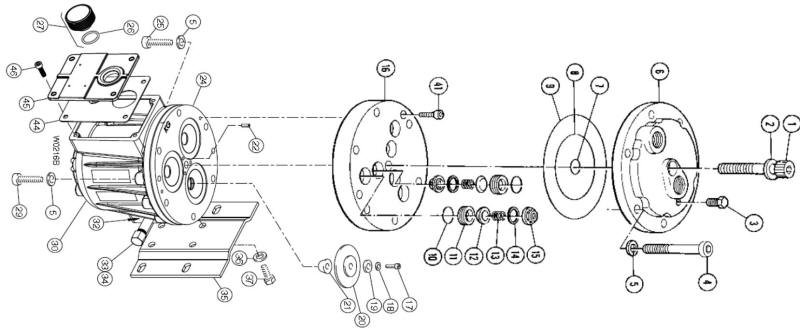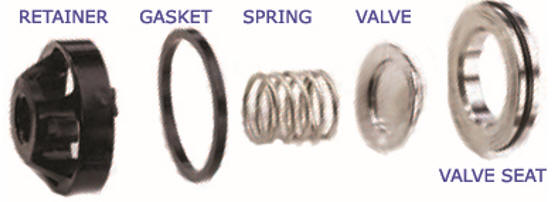Component Breakdown of Wanner™ Hydra-Cell® Pro Pumps
Description of components in contact with the pumped liquid

 Article- Components of Hydra-Cell pumps
Article- Components of Hydra-Cell pumps
Components of a Wanner™ Hydra-Cell® Pro Pump
Hydra Cell Pro pumps are
sealless positive displacement pumps whose only components in contact with the
pumped fluid are the elastomers and check valve assemblies. This article
describes the function of these components, lists the available materials of
construction and provides additional information in support of selecting the
most appropriate materials for your application.
Most Hydra Cell Pro pumps have a
12-character part number with each character associated with a specific pump
characteristic. Choice of the best suited materials for your application
improves reliability and reduces downtime as well as labor and parts costs
associated with maintenance.
D10ERCGHFECA
This article focuses in on the
materials in contact with the pumped fluid and their function, which are defined
with the 6th – 11th characters of the part number.

The first characters reference the Hydra Cell Pro pump model, so in the example
above the part number is for a model D10 Hydra Cell Pro pump. The 4th
character references the flow rate at a given RPM. The purpose of this
customization is to establish the desired flow rate at an appropriate fluid
velocity; abrasive fluid applications benefit from lower velocities across the
internal check valve assemblies because it corresponds directly to reduced check
valve wear.
The 5th character describes an aspect about the pump head
or the hydraulic cylinder of the pump. The 12th character is a
reference to the type of oil used in the hydraulic end of the pump. Most
applications use a common 10W30 or 10W40 synthetic motor oil although there are
specialized applications requiring food contact and other specialty oils.

The pump head consists of two parts, the
manifold and the check valve plate. These components often last the life
of the pump and are selected based upon chemical compatibility with the pumped
fluid. Hydra-Cell pump heads are offered in a variety of alloy and
non-alloy materials:
-
316LSS: an iron alloy generally required for low and high PH fluids as well as applications using stainless steel piping
-
Brass: consisting of about 60% copper and 36% zinc its an inexpensive material for water and other non-aggressive liquids
-
Duplex Alloy 2205: typically used for sea water and marine environments because it is twice as corrosion resistant than 316SS for those applications
-
Hastelloy® C: a nickel alloy providing a broader range of chemical and corrosion resistance than 316SS and capable of higher pressures then non-alloys
-
Nickel-plated cast or ductile iron: The least expensive pump head material used for both water and hydrocarbon-based liquids as well as abrasive slurries
-
Polypropylene: used for chemical resistance and less expensive than exotic alloys
-
PVDF: provides better abrasion resistance and chemical resistance than polypropylene
The pump head is not considered a wear item, even when the
fluid is an abrasive slurry.

These are the
diaphragms, o-rings and gaskets – all almost exclusively selected based upon
chemical compatibility with the pumped fluid:
-
Aflas®: 80 to 250°F, a fluoroelastomer which offers better resistance to amines than FKM
-
EPDM: 50 to 212°F, resistant to chemistries where FKM is not compatible and PTFE or Aflas aren’t available for a given pump model. Requires a special hydraulic end oil
-
FKM: 40 to 250°F, a partially fluorinated material having low gas permeability, well suited for petroleum products and a variety of common industrial chemicals including aromatic and chlorinated hydrocarbons
-
PTFE: 60 to 200°F, a fully fluorinated and impermeable material, highly resistant to a variety of chemicals including strong acids and oxidizing agents. Consisting of a light-blue PTFE material laminated onto a black rubber backing, it is the only diaphragm material which is considered a wear item
-
Neoprene®: 50 to 120°F, excellent resistance to refrigerants, vegetable oils, ammonia and halon
-
Buna-N®: 30 to 230°F, general purpose for oil, water and solvents that are not highly polar
Diaphragms are often replaced when replacing
the check valves because it is easy to do and “resets the clock” on all the
materials within the pump head. Diaphragms are damaged by chemical
incompatibility, over-pressurization and extreme temperatures. With the
exception of PTFE diaphragms, physical wear is only cosmetic. O-rings and
gaskets enforce the desired flow path and are replaced each time the pump is
serviced.
Characters #8-9: Valves and Valve Seats
The valve disc sealing
against its corresponding valve seat is responsible for maintaining the flow
path from inlet to outlet of the pump. Each revolution of the pump shaft causes
the valve and seat to “mate” and can cycle up to 30 times per second!
These are the main wear items of Hydra-Cell pumps. You know they are worn
when the flow rate/pressure decreases. It is a gradual type of wear and
not sudden nor catastrophic; just a slightly louder sounding, rougher running
pump.

How long do Hydra Cell Pro check valves last?
There is no direct answer
to this question, we can only estimate based upon prior experience with similar
fluids. Applications involving reclaimed water or machining coolant using
stainless steel valves/seats will likely last 6000 hours (8+ months of
continuous use). 25% lime slurry applications might last as long, however
only if operating the pump at lower RPMs (reducing velocity across the
valves/seats) and using an abrasion resistant material such as ceramic.
Selecting
the check valve material involves consideration of both chemical compatibility
and economical longevity. Stainless steel valves for a high-pressure water
application operated only 8 hours a day could last over 2 years; it would be
tough justifying the cost of using tungsten carbide even though that material
lasts 20 times longer (40 years!) because it costs 36 times more than SS.
We select check valve materials that will last approximately 6-9 months given
what we know about similar customers and applications. The following materials
are suitable for 15 to 250°F:
-
Ceramic: used for abrasive resistance and liquids aggressive to alloys
-
17-4 stainless steel: has slightly better wear resistance than 316SS due to its hardness
-
316L stainless steel
-
Hastelloy® C
-
Nitronic® 50: an austenitic stainless steel more chemically resistant and having superior sub-zero temperature performance than 316 stainless steel
-
Tungsten carbide maximizes abrasion resistance
Character #10: Valve Spring
The valve spring
is the only component in contact with the pumped fluid that must be an alloy
material. The springs are not considered a wear item unless the fluid is
not chemically compatible. These ensures quick re-seating of the check
valve and are compatible with temperatures of 15 to 250°F:
-
17-7 stainless steel, has slightly better wear resistance than 316SS due to its hardness
-
Elgiloy: a nickel cobalt alloy more corrosive resistant than stainless steel and resists fatigue from temperature and set-resistance better than Hastelloy® C or stainless steel
-
Hastelloy® C
Character #11: Valve Spring
Retainer
The retainer is the component which compresses the spring which
in-turn seals the valve against its seat. The compression of the retainer
is accomplished by sandwiching it between the pump manifold and valve seat.
This is not considered to be a wear item as they are damaged by chemical
incompatibility or an upset condition involving an extreme temperature.
Retainers are available in the following materials:
-
17-7 stainless steel: 15 to 250°F
-
Celcon (Polyoxymethylene): 15 to 160°F, resistant to alcohols, hydrocarbons, water, most agricultural chemicals, esters and ethers
-
PVDF, 15 to 160°F
-
Polypropylene: 15 to 160°F
-
Hastelloy® C: 15 to 250°F
-
Nylon (Zytel®): 15 to 160°F, resistant to benzene, ethylene glycol, gasoline, hexane, methanol, freon and ethanol
Our web-based repair kit part number and pricing calculator (Click
Here) will convert your pump part number into the three repair
kit part numbers (elastomers only, check valves only and a complete kit
containing both).





